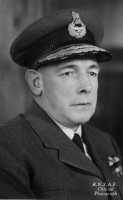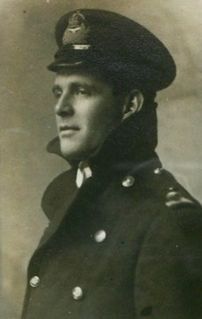Biography
Ladd was born in Warkworth north of Auckland, New Zealand on 27 October 1908. After time in Auckland and Wellington, the family settled in Hamilton, where he attended Hamilton High School for one year. After a variety of jobs, he joined his father's carrying business in 1925 and took it over the following year after his father's death. He ran the company for 15 years. He was interested in flying, but did not have the means to pay for lessons until 1939. He joined the Royal New Zealand Air Force in 1941 and graduated as a pilot in the following year. During World War II, he flew 33 missions in the Pacific. [1]

Warkworth is a town on the Northland Peninsula in the upper North Island of New Zealand. It is in the northern part of the Auckland Region. It is located on State Highway 1, 64 km north of Auckland and 98 km south of Whangarei, and is at the head of Mahurangi Harbour.

Auckland is a city in the North Island of New Zealand. Auckland is the largest urban area in the country, with an urban population of around 1,628,900. It is located in the Auckland Region—the area governed by Auckland Council—which includes outlying rural areas and the islands of the Hauraki Gulf, resulting in a total population of 1,695,900. A diverse and multicultural city, Auckland is home to the largest Polynesian population in the world. The Māori-language name for Auckland is Tāmaki or Tāmaki-makau-rau, meaning "Tāmaki with a hundred lovers", in reference to the desirability of its fertile land at the hub of waterways in all directions.

Wellington is the capital city and second most populous urban area of New Zealand, with 418,500 residents. It is located at the south-western tip of the North Island, between Cook Strait and the Remutaka Range. Wellington is the major population centre of the southern North Island, and is the administrative centre of the Wellington Region, which also includes the Kapiti Coast and Wairarapa. Its latitude is 41°17′S, making it the world's southernmost capital of a sovereign state. Wellington features a temperate maritime climate, and is the world's windiest city by average wind speed.
Ladd started flying the Dunedin–Invercargill route for the New Zealand National Airways Corporation in 1948. With a strong entrepreneurial streak, he was the first Chief Pilot for Fiji Airways (1951–1954), before running his own company for 13 years, Tourist Air Travel, in the Hauraki Gulf. During that time, he became a household name in New Zealand, and was known for his catch phrases like "a shower of spray and we're away" for taking off in his Widgeon, an amphibious aircraft. On his last day as a tourist operator in 1967, he flew his Widgeon under the Auckland Harbour Bridge and was discharged without conviction for this offence. With over 21,000 hours of flying time, he had his commercial pilot's licence withdrawn by the Civil Aviation Authority in 1977 over age concerns. Ladd embarked on a fitness campaign for regaining his licence and set a national swimming record in the over 70 category, but was unsuccessful. In December 1983, he commenced gliding. [1]

Dunedin is the second-largest city in the South Island of New Zealand, and the principal city of the Otago region. Its name comes from Dùn Èideann, the Scottish Gaelic name for Edinburgh, the capital of Scotland.

Invercargill is the southernmost and westernmost city in New Zealand, and one of the southernmost cities in the world. It is the commercial centre of the Southland region. The city lies in the heart of the wide expanse of the Southland Plains on the Oreti or New River some 18 km north of Bluff, which is the southernmost town in the South Island. It sits amid rich farmland that is bordered by large areas of conservation land and marine reserves, including Fiordland National Park covering the south-west corner of the South Island and the Catlins coastal region.
New Zealand National Airways Corporation, popularly known as NAC, was the national domestic airline of New Zealand from 1947 until 1978 when it amalgamated with New Zealand's international airline, Air New Zealand. The airline was headquartered in Wellington.
In the 1963 New Year Honours, Ladd was appointed a Member of the Order of the British Empire, for services to the people of Waiheke Island and other areas in the Hauraki Gulf in connection with rescue work and transport of the sick. [2] He was promoted to Officer of the same order in the 1976 Queen's Birthday Honours for services to the tourist and aviation industries. [3]
The New Year Honours 1963 were appointments in many of the Commonwealth realms of Queen Elizabeth II to various orders and honours to reward and highlight good works by citizens of those countries. They were announced in supplements to The London Gazette of 28 December 1962 to celebrate the year passed and mark the beginning of 1963.

The Most Excellent Order of the British Empire is a British order of chivalry, rewarding contributions to the arts and sciences, work with charitable and welfare organisations, and public service outside the civil service. It was established on 4 June 1917 by King George V and comprises five classes across both civil and military divisions, the most senior two of which make the recipient either a knight if male or dame if female. There is also the related British Empire Medal, whose recipients are affiliated with, but not members of, the order.

Waiheke Island is the most populated and second-largest island in the Hauraki Gulf of New Zealand. Its ferry terminal in Matiatia Bay at the western end is 21.5 km (13.4 mi) from the central-city terminal in Auckland.
Ladd died of cancer on 22 January 1989 at Taupo, survived by his wife and daughter. [1] His ashes were buried in Taupo Public Cemetery. [4]

Taupo is a town on the shore of Lake Taupo, which occupies the caldera of the Taupo Volcano in the centre of the North Island of New Zealand. It is the seat of the Taupo District Council and lies in the southern Waikato Region.









